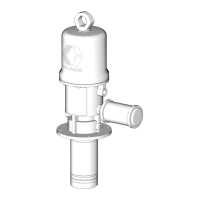Installation
308655K 7
Grounding
Follow local electrical code for detailed grounding
instructions.
Pump:
Refer to F
IG. 2 for the following instructions.
1. Remove the ground screw (Z) located on the side of
the pump base.
2. Insert the ground screw (Z) through the eye of the
ring terminal (W) located at the end of the ground
wire (Y).
3. Fasten the ground screw (Z) back onto the back of
the pump and tighten the screw securely.
4. Connect the other end of the ground wire (Y) to a
true earth ground. To order a ground wire and
clamp, order Part No. 222011.
Air and fluid hoses: use only electrically conductive
hoses.
Air compressor: follow manufacturer’s
recommendations.
Fluid supply container: follow local code.
To maintain grounding continuity when flushing or
relieving pressure: hold metal part of the dispense
valve firmly to the side of a grounded metal pail, then
trigger the valve.
Mounting
Install the pump in a location that adequately supports
the weight of the pump when filled with lubricant and
also provides easy operator access to the pump air
controls. The pump must be mounted in a vertical posi-
tion. See Technical Specifications, page 20 for pump
weight information and the Dimensions and Mounting
Hole Layout, page 19.
Cover Mount
Pump Model 222065 is designed for mounting directly
onto a 55-gallon drum cover. When the pump is
mounted to a closed-head drum, loosen the vent plug
on the drum cover to prevent a vacuum in the drum. For
cover mounting, see the Mounting Hole Layout,
page 19.
Wall Mount
The pump shown in FIG. 1 is a wall mounted universal
pump, Model 205626. To oder the wall mounting
bracket, order Part No. 238425.
Bung Mount
Pump model 222095 is designed for bung mounting on
a 55-gallon drum. The bung adapter (153) is shown in
Parts, page 16.
The equipment must be grounded to reduce the risk
of static sparking. Static sparking can cause fumes
to ignite or explode. Grounding provides an escape
wire for the electric current.
FIG. 2
Z
W
Y
Mount the pump securely so that it cannot move
around during operation. Failure to do so could result
in injury or equipment damage.

